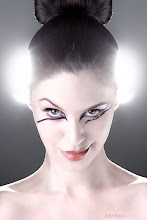looking up some e-poetry
I had a look at the InFlect website and found some inspiration in some of the pieces there, for example:
John Sparrow – “Eye in the Making”
At first I didn’t know if I liked this or not because after waiting for ages for it to load it only seemed to be a tiny image, but once I found that you could click on the words I enjoyed my experience with it. This poem is almost completely interactive, and the experience is heightened by the addition of the sound elements within it. The graphic element is pretty simple, just a black screen with some mediocre little images of walking through a building, but I’m sure it relates somehow, and I do like it better than I would if it didn’t have any pictures or moving images at all. I’m glad I turned my speakers on in preparation of watching this because I enjoyed the sounds in it – the random fragments of someone talking mirrored the fragments of words that were being created, and also gave you a sense that this was a poem, which may have been lost if the sounds were just music.
The way this piece gave me inspiration was the way that the poem was constructed purely through interactivity as you had to press on the words to make more words come up. I assume this was done in flash but I don’t entirely know how. However I found that I didn’t ever bother to read any of the text, finding myself more carried away with the interactivity and the sounds, also every time I tried to read the words the lines seemed far too abstracted to really mean anything. I think Sparrow should have made this piece a bit longer, in the info page it says this piece is created of 3 lots of text, which doesn’t seem like very much to me. I would have enjoyed being able to be in the experience for longer, and I found myself repeating the whole thing just to try and draw it out.
Next I wanted to chose a piece that was by a woman (from the InFlect site) to compare with the Sparrow piece, so I looked at “House” by Mary Flanagan. It ended up being a zip file that I had to download to my computer, I think because it works on the basis of what your computer is doing. I thought it was a nice idea, but it came up rather small on my screen (about 3 or 4 inches wide) and I don’t know how to get it any bigger or whether it is meant to be this size. Therefore it’s hard to read the text. The page doesn’t seem to change much, just the amount of ‘houses’ can become more or less, and the text can change. You can use your mouse to pull the houses around, and if you pull them in close to you the text is easier to read, but you can only see a bit of it at a time.
I let it just sit for a while on my computer while I did other things then went back to check on it and found that while the houses were distanced from the screen there was text floating very close past the screen which looked cool, and then I did it again and the houses were off in the left hand corner, but they were no longer houses and just boxes. Overall (I may just be unaware of how it works) I couldn’t see how it was a very interactive piece, and again, like the last one, I didn’t feel compelled to even want to read the text, and the graphic and interactive elements seemed more interesting. What I did like about the placement of the text in this one was that it wasn’t always the right way up, so that if you did read a line you would have to turn your head and move your body, which is interactive in another level. I didn’t draw too much inspiration from this piece but I suppose it did make me think about colour and also 3D spacing, which the first piece did not have. This piece seems more sophisticated in the way that it is made (due to the 3D effects and the movement of the text and everything else, but less involving for the onlooker perhaps.


0 Comments:
Post a Comment
<< Home